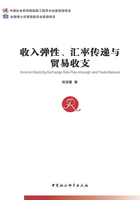
Abstract
On the background of global economic slowdown and trade shrinking,China's trade surplus began to narrow.This requires us to find factors that determine trade balance and its states,and then predict trade balance of China,which is great significance to the stability of China's macro-economy and economic growth.
However,the existing trade balances theories,especially elasticity analysis,are focusing on exchange rate and neglecting the role of income.At the same time,there is a lack of measurement of the impact of exchange rate on trade balance,and there are also big problems in measurement of trade elasticity.
According to above problems,this book improves trade balance elasticity theoretical framework firstly,including puts income and exchange rate into analysis framework at the same time,splits the trade balance into two aspects:volume and price,clarifies income influences on trade balance volume,exchange rate influences on the price of trade balance,and expands the Marshall-Lerner conditions.Then,basing on the HS-6 data from 1996 to 2016,this book chooses purchasing power parity and constant GDP and GDP per capita as the proxy variable of income,bilateral nominal exchange rate as the proxy variable of exchange rate,and empirically calculates income elasticity,price elasticity,exchange rate pass-through degree and the impact of exchange rate of China's aggregate,bilateral and sub-industry trade balance.Furthermore,this book makes a cross-border comparative analysis of four countries,including China,Germany,Japan and the United States.By doing so,this book tries to explain trade balance stage by the differences of income elasticity,which provides support for predicting China's trade balance trend.
The main findings of this book are as follows:Firstly,whatever aggregate or bilateral cases,the impact of income on China's trade balance is far greater than that of exchange rate.In particular,in bilateral trade of China and United States,the huge trade deficit is mainly determined by income difference of these two countries,and the role of exchange rate is very limited;Secondly,by examining the long-term and short-term differences and asymmetry of exchange rate pass-through,we found that Chinese exporters' bargaining power is a little weak,and in the long run,foreign exporters have a certain monopoly in China's market.Third,exchange rate is still an effective tool to adjust trade balance in sub-sectors,although it has little impact on aggregate trade balance.Particularly,the impact of exchange rate changes on middle-tech intensive represented by machinery and high-tech intensive industries represented by aviation is more significant.Fourthly,combing with trade balance stage theory and experience in transition from surplus to deficit of major developed countries,this book analyses annual change of income elasticity of China,and forecasts China's trade balance surplus will maintain for a certain period of time.Trade friction between China and United States will indeed have an impact on China's trade balance,but it will not change China's trade balance stage.
The innovations of thisbook are as follows:Firstly,this book improves theoretical framework of trade balance elasticity analysis,examines factors that influencing trade balance from two dimensions of quantity and price,clarifies the channel and mechanism of income and exchange rate that influencing on trade balance,and expands Marshall-Lerner condition;Secondly,this book makes effort to explain stage characteristics of trade balance by using elasticity theory of trade balance,which means that using import and export income elasticity to explain trade balance stage.Thirdly,this book uses data of 1996 to 2016,which is more comprehensively reflecting the stage changes of China's trade balance,and makes us to investigate the impact of China's economic development and exchange rate changes on trade balance.Fourthly,this book uses bilateral and industrial HS-6 code data to better investigate heterogeneity in bilateral and industrial.
Keywords:Income Elasticity;Exchange Rate Pass-through;Marshall-Lerner condition;Trade Balance